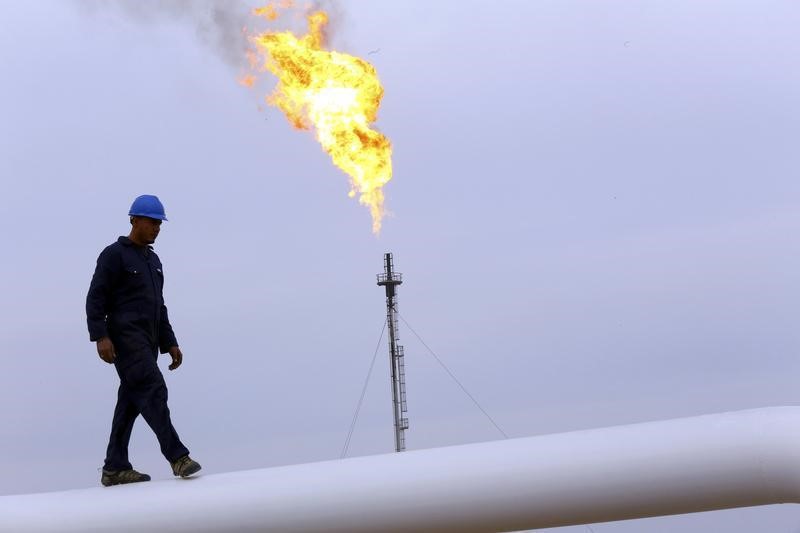Investing.com - Crude prices fell on the last trading day of September on growing uneasiness over how the world might cope in the coming months with exploding energy costs, even as the U.S. economy and inflation appeared to have escaped the worst of such impact right away. Those long oil also won big on the month and quarter, helped largely by chokes on Saudi and Russian supply.
New York-traded West Texas Intermediate, or WTI, crude for delivery in November settled at $90.79 per barrel, down 92 cents, or 1%, on the day.
While WTI fell on the day, it rose 0.8% on the week, resuming its rally from the end of August after a one-week hiatus last week. For the month, the U.S. crude benchmark rose 8.5%, making September its best since July’s gain of nearly 16%.
The July-September period, where WTI rose 26.5%, also marked the best quarter for the U.S. benchmark since the first three months of 2022. Then WTI traded as high as $130 a barrel as Russia’s invasion of Ukraine opened the way for Western sanctions on Moscow that began the long-running disruption in global commodity flows. Now, WTI is within striking range of triple-digit pricing, reaching a 13-month high of $95.03 on Sept. 28.
London-traded Brent for the most-active December contract settled at $92.20 a barrel, down 90 cents, or 1%, on the day. The global crude benchmark rose 0.3% on the week, 6.8% on the month and 23% for the quarter. The global crude benchmark reached a 10-month high of $95.35 on Sept. 28.
“After an amazing week, month and quarter, oil was ready for some profit-taking,” said Ed Moya, analyst at online trading platform OANDA. “Energy traders quickly realized this wasn't the time for oil to rally above the $100 a barrel level, so they are cautiously locking in some profits.”
Oil prices have gained between $25 and $30 from May lows of beneath $64 for WTI and $72 for Brent. The rally was largely in response to cumulative production squeezes of at least 1.3 million barrels per day by Saudi Arabia and Russia. The two say they are trying to “balance” the market — though the reality is they are creating a supply deficit so great versus stagnant demand that prices would have no choice but to rise.
The two prime movers of OPEC+ — an alliance which bands the 13-member Saudi-led Organization of the Petroleum Exporting Countries with 10 independent oil producers steered by Russia — have also benefited from tacit collusion on output from U.S. oil producers.
While antitrust laws forbid U.S. energy companies from participating in OPEC-like schemes that are against the spirit of free-market competition, American oil firms, lured by the Saudi bent in getting a barrel back to above $100, have restrained production too whenever possible in the name of returning cash to shareholders.
The Saudis, Russians and rest of OPEC+ will meet again next week to review the impact of their production cuts on the market and what to do going forward.
Demand for U.S. crude has, meanwhile, exploded internationally as it begins to fill some pockets underserved by the Saudi-Russian squeeze. That has led to a plunge in inventory levels at the Cushing, Oklahoma hub that serves as a central delivery and storage point for U.S. crude. This is especially so with the pick up in shipments of a new U.S. crude grade called WTI Midland — which is comparable to the viscosity of the heavier Arab and Russian oils versus the typically light-grade that’s WTI.
Analysts: Overbought oil market needs to correct
OANDA’s Moya isn’t the only one who thinks the oil rally will have to cool with the global economy.
Reuters' market analyst John Kemp says oil traders have placed so many bullish bets on crude prices that the trade has become overcrowded and was due for a correction.
In his latest column on oil buying among institutional traders, Kemp pointed out that over the past four weeks, traders had bought a total of 183 million barrels of crude and fuel futures. That has brought the total up to 525 million barrels. More importantly, the ratio of bullish to bearish bets on oil and fuels had risen to almost 8:1.
According to Kemp, this is a sign that oil prices may start reversing their gains before too long.
Others, however, anticipate even higher prices, with JP Morgan saying this week that Brent could reach $150 per barrel. Other commodity analysts see Brent hitting $100 before this year's end.
But Wall Street’s forecasters are often too caught up in chasing a market one way that they ignore counteracting forces. And one of the bigger risks to the oil rally remains the Federal Reserve and its higher-for-long regime for U.S. interest rates.
Energy-driven inflation, economic worries ahead for Q4
Fed Chair Powell told a news conference last week that energy-driven inflation was one of the central bank’s bigger concerns.
The Fed has raised interest rates 11 times between March 2022 and July 2023, adding a total of 5.25 percentage points to a prior base rate of just 0.25%. It could add another quarter point in November or December and more likely in 2024.
U.S. Treasury yields, benchmarked to the U.S. 10-year note, shot to fresh 16-year highs on Thursday, on expectations over Fed hikes. That bond market selloff could do the oil rally in ultimately, say analysts.
The US Dollar Index remained stubbornly at around 106 on Friday — adding to the weight on gold — after a 10-month high of 106.84 on Wednesday.
The dollar has been little changed despite latest inflation data that raised hopes that the Federal Reserve might extend its hold on interest rates at its November policy meeting. The Personal Consumption Expenditure Index, a price gauge closely followed by the Fed, rose 0.4% last month, just below Wall Street expectations for a 0.5% rise.
(Peter Nurse and Ambar Warrick contributed to this item)
